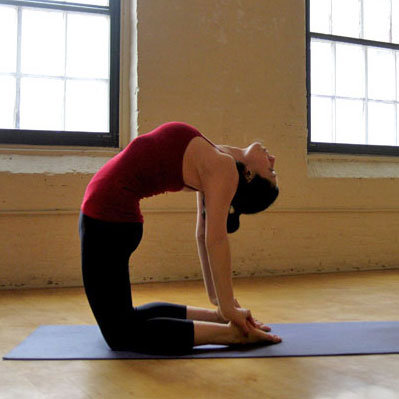A month ago I was exercising rarely and had packed 5 extra
pounds on my thighs and backside to prove it. My favorite blue jeans were
banished to the back of a drawer, and I was fidgeting in bed every night. I was
exhausted but too wired to sleep. It was awful. But I'd be lying if I said it
was unusual. As a freelance writer, part-time editor, and live-in girlfriend to
a night-owl musician, I work crazy hours and go out as often as I can. Sure,
I'd go on mini health kicks for a week here and there. Then I'd get bored and
return to pulling all-nighters and gorging on nachos. In a way, I was the worst
person to test
yoga for weight loss potential. But, in another, I was the
best. Most people fall off the exercise wagon as quickly and as often as I do.
If I could make yoga stick and slim down, it would bode well for yo-yo dieters
everywhere. It would also be pretty surprising, considering that
yoga is farbetter known for promoting relaxation than burning fat.

As a sporadic fitness fan, I'd taken yoga classes at gyms
and studios around New York, and had even done Bikram one or two times a week
for almost a month last summer (until a beer-soaked trip to Europe broke my
momentum). My objective was to find a way to do yoga no less than four times a
week and see if that alone—I planned to eat the same as always, no
dieting—would melt away my excess flab. It took a hefty amount of trial and
error to find a routine that fit my unpredictable life. But by the end of Week
3, I was shocked to discover that yoga was starting to become a part of who I
was—and that the number on the scale was steadily dropping.
Week 1: No Way Om
Since I had fond, if fuzzy, memories of hot yoga, I slotted
it in for two of my four weekly workouts. Only now I lived 30 blocks from the
nearest Bikram studio and, on most days of the week, work would make my only
option an 8 PM class. Not ideal, but worth a try.
That first Monday I was working at home and struggling to
meet a monster deadline. When 7:30 rolled around, I struggled to shift gears. Yoga.
Yoga. What did I need for yoga? It was 7:58 when I rolled in, and the place was
packed with a crowd that was as unrealistically fit and attractive as the cast
of Lost. I shimmied through the swarm of bodies in the locker room, changed
hunched over in a corner, and had to ask two chatting Evangeline Lily
look-alikes to make room for my mat on the floor. Apparently Bikram had become
way more popular since the last time I tried it.
I did my best to focus as I followed the teacher through the
26 postures over the course of 90 sweltering minutes (the room was heated to a
suffocating 105 degrees). After class I was so dizzy I had to stand next to my
bike for a while, just breathing the cool night air, before I felt steady
enough to ride. When I got home, it was 10 p.m., and I still had to shower. My
boyfriend and dog shot me accusatory looks from the couch as I headed to bed
completely exhausted—only one night into my weight-loss experiment, and I was
already neglecting my family.
The two slow-moving hatha classes I took that week were a
walk in the park. There's a low-key studio right around the corner from our
condo and the classes were blissfully small though still time-consuming at 75
minutes. Another downside: They were a little too easy. The stretching felt
wonderful and my muscles were getting a mild workout from all those warrior Is,
IIs, and IIIs, but it seemed like a shame to exercise for that long yet burn so
few calories.
By Friday I had somehow managed to drop a pound and was
already sleeping better and feeling less tense. My outlook, on the other hand,
was crappy. There was no way I had the time or money to keep this up. Four
classes had added up to $64, and I hadn't run a single errand or seen a friend
all week. If I wanted to meet my goal of becoming a size 4 yogi, I was going to
need a Plan B.




.jpg)